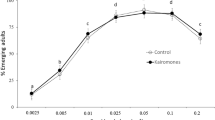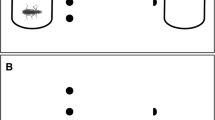Abstract
Tadpoles and mosquito larvae often co-occur, and may compete for scarce resources. However, competition between such distantly related organisms has attracted less scientific attention than have interactions among closely related taxa. We examined ecological interactions in two tadpole-mosquito systems in southeastern Australia, one from freshwater ponds (Limnodynastes peronii and Culex quinquefasciatus) and one from brackish-water habitats (Crinia signifera and Ochlerotatus australis). Diets of these tadpoles and mosquito larvae overlap considerably, potentially leading to competition for food. Laboratory experiments show that, in both study systems, mosquitoes reduced the growth rates of tadpoles, and tadpoles reduced the growth rates and survival of mosquito larvae. These negative effects were seen even at high food levels. Thus, our study suggests that tadpoles and mosquito larvae affect each other strongly, and do so via pathways other than simple consumptive competition. Because mosquitoes are important vectors for human diseases, the global decline in amphibian populations may have more impact on human health than has generally been anticipated.




Similar content being viewed by others
References
Alford RA (1999) Ecology: resource use, competition, and predation. In: McDiarmid RW, Altig R (eds) Tadpoles—the biology of anuran larvae. University of Chicago Press, Chicago, pp 240–278
Barrera R, Medialdea V (1996) Development time and resistance to starvation of mosquito larvae. J Nat Hist 30:447–458
Bern L, Dahl C (2000) Ingestion of algae and inert particles by larval Culex quinquefasciatus. Arch Hydrobiol 147:25–33
Blaustein L, Margalit J (1994) Mosquito larvae (Culiseta longiareolata) prey upon and compete with toad tadpoles (Bufo viridis). J Anim Ecol 63:841–850
Blaustein L, Margalit J (1996) Priority effects in temporary pools: nature and outcome of mosquito larva-toad tadpole interactions depend on order of entrance. J Anim Ecol 65:77–84
Bronmark C, Rundle SD, Erlandsson A (1991) Interactions between freshwater snails and tadpoles: competition and facilitation. Oecologia 87:8–18
Brown JH, Davidson DW (1977) Competition between seed eating rodents and ants in desert ecosystems. Science 196:880–882
Cabin RJ, Mitchell RJ (2000) To Bonferroni or not to Bonferroni: when and how are the questions. Bull Ecol Soc Am 81:246–248
Carpenter FL (1979) Competition between humming birds and insects for nectar. Am Zool 19:1105–1114
Chessman BC (1986) Dietary studies of aquatic insects from two Victorian rivers. Aust J Mar Freshwater Res 37:129–146
Cogger HG (2000) Reptiles and amphibians of Australia. Reed New Holland, Sydney
Connell JH (1983) On the prevalence and relative importance of interspecific competition: evidence from field experiments. Am Nat 122:661–696
Darwin C (1859) On the origin of species. Murray, London
Diamond J (1987) Competition among different taxa. Nature 326:241
Farlowe V (1928) Algae of ponds as determined by examination of the intestinal contents of tadpoles. Biol Bull 55:443–448
Gosner KL (1960) A simplified table for staging anuran embryos and larvae with notes on identification. Herpetologica 16:183–190
Griffiths RA, Denton J, Wong ALC (1993) The effect of food level on competition in tadpoles—interference mediated by Protothecan algae. J Anim Ecol 62:274–279
Gurevitch J, Morrow LL, Wallace A, Walsh JS (1992) A meta-analysis of competition in field experiments. Am Nat 140:539–572
Hart DD (1985) Grazing insects mediate algal interactions in a stream benthic community. Oikos 44:40–46
Hurlbert SH, Loayza W, Moreno T (1986) Fish-flamingo-plankton interactions in Peruvian Andes. Limnol Oceanogr 31:457–468
Jenssen TA (1967) Food habits of the green frog, Rana clamitans, before and during metamorphosis. Copeia 1967:214–218
Kenny JS (1969) Feeding mechanisms in anuran larvae. J Zool Lond 157:225–246
Kupferberg SJ (1997) The role of larval diet in anuran metamorphosis. Am Zool 37:146–159
Kupferberg SJ, Marks JC, Power ME (1994) Effects of variation in natural algal and detrital diets on larval anuran (Hyla regilla) life-history traits. Copeia 1994:446–457
Lotka AH (1932) The growth of mixed populations: two species competing for a common food supply. J Wash Acad Sci 22:461–469
McLachlan AJ (1981) Interactions between insect larvae and tadpoles in tropical rain pools. Ecol Entomol 6:175–182
McLachlan AJ (1985) What determines the species present in a rain pool? Oikos 45:1–7
Merritt RW, Craig DA (1987) Larval mosquito (Diptera: Culicidae) feeding mechanisms: muco-substance production for capture of fine particles. J Med Entomol 24:275
Merritt RW, Dadd RH, Walker ED (1992) Feeding behaviour, natural food, and nutritional relationships of larval mosquitoes. Annu Rev Entomol 37:349–376
Mokany A (2001) Ecological and behavioural interactions between tadpoles and mosquito larvae. BSc Thesis, University of Sydney
Mokany A, Shine R (2002a) Pond attributes influence competitive interactions between tadpoles and mosquito larvae. Aust Ecol 27:396–404
Mokany A, Shine R (2002b) Oviposition site selection by mosquitoes is affected by cues from conspecific larvae and anuran tadpoles. Aust Ecol (in press)
Morin PJ (1983) Predation, competition, and the composition of larval anuran guilds. Ecol Monogr 53:119–138
Morin PJ, Lawler SP, Johnson EA (1988) Competition between aquatic insects and vertebrates: interaction strength and higher order interactions. Ecology 69:1401–1409
Mpho M, Holloway GJ, Callaghan A (2000) Fluctuating wing asymmetry and larval density stress in Culex quinquefasciatus. Bull Entomol Res 90:279–283
Newman RA (1994) Effects of changing density and food level on metamorphosis of a desert amphibian, Scaphiophus couchii. Ecology 75:1085–1096
Newman RA (1998) Ecological constraints on amphibian metamorphosis: interactions of temperature and larval density with response to changing food level. Oecologia 115:9–16
Osborne PL, McLachlan AJ (1985) The effects of tadpoles on algal growth in temporary, rain-filled rock pools. Freshwater Biol 15:77–88
Pechmann JHK, Scott DE, Semlitsch RD, Caldwell JP, Vitt LJ, Gibbons JW (1991) Declining amphibian populations: the problem of separating human impact from natural fluctuations. Science 253:892–895
Peterson CG, Boulton AJ (1999) Stream permanence influences micro-algal food availability to grazing tadpoles in arid-zone springs. Oecologia 118:340–352
Pyke GH, White AW (1999) Dynamics of co-occurring frog species in three ponds utilised by the endangered Green and Golden Bell frog Litoria aurea. Aust Zool 32:230–239
Rashed SS, Mulla MS (1990) Comparative functional morphology of the mouth brushes of mosquito larvae (Diptera: Culicidae). J Med Entomol 27:429–439
Robinson M (1996) A field guide to the frogs of Australia, from Port Augusta to Fraser Island including Tasmania. Reed, Melbourne
Rosenfeld JS (1997) The effect of large macroinvertebrate herbivores on sessile epibenthos in a mountain stream. Hydrobiologia 344:75–79
Russell RC (1993) Mosquitoes and mosquito-borne disease in south-eastern Australia. Medical Entomology, Westmead
SAS Institute (1998) Statview 5. Cary, Ind
Seale DB, Beckvar N (1980) The comparative ability of anuran larvae (Genera: Hyla, Bufo and Rana) to ingest suspended blue-green algae. Copeia 1980:495–503
Seale DB, Wassersug RJ (1979) Suspension feeding dynamics of anuran larvae related to their functional morphology. Oecologia 39:259–272
Snedecor GW, Cochran WG (1980) Statistical methods. Iowa State University Press, Iowa
Steinwascher K (1979) Host-parasite interaction as a potential population regulating mechanism. Ecology 60:884–890
Vitt LJ, Caldwell JP, Wilbur HM, Smith DC (1990) Amphibians as harbingers of decay. Bioscience 40:418
Walker ED, Olds EJ, Merritt RW (1988) Gut content analysis of mosquito larvae (Diptera: Culicidae) using DAPI stain and epifluorescence microscopy. J Med Entomol 25:551–554
Walker ED, Lawson DL, Merritt RW, Morgan WT, Klug MJ (1991) Nutrient dynamics, bacterial populations and mosquito productivity in tree hole ecosystems and microcosms. Ecology 72:1529–1546
Widahl L (1992) Flow patterns around suspension feeding mosquito larvae. Ann Entomol Soc Am 85:91–95
Wilbur HM (1997) Experimental ecology of food webs: complex systems in temporary ponds. Ecology 78:2279–2302
Acknowledgements
We thank Mike Thompson and Angela Low for collecting tadpoles. The Australian Research Council provided financial support for this study.
Author information
Authors and Affiliations
Corresponding author
Rights and permissions
About this article
Cite this article
Mokany, A., Shine, R. Competition between tadpoles and mosquito larvae. Oecologia 135, 615–620 (2003). https://doi.org/10.1007/s00442-003-1215-6
Received:
Accepted:
Published:
Issue Date:
DOI: https://doi.org/10.1007/s00442-003-1215-6




